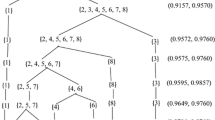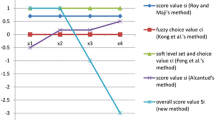Abstract
Graph node clustering methods, which aim to partition graph vertices into several disjoint groups of data with similar features, are usually fulfilled based on topological structural similarity of nodes, such as connectivity between vertices or neighborhood similarity of them. However, the attribute-based clustering is recently challenging to data clustering. The present paper contributes to considering a novel data clustering algorithm, called FBC-Cluster, based on fuzzy multigraphs in terms of both structural and attribute similarities. In the proposed algorithm, attribute similarity is achieved through m-polar fuzzy T-equivalences among alternatives (objects) and structural similarity is defined based on a new similarity measurement, called behavioral similarity index, using closed neighborhood in the attributed clusters. The output of the proposed clustering algorithm includes two main categories, namely certain and possible clusters, based on threshold level \(\beta\) given on the behavioral similarity index. A numerical example is discussed to demonstrate the performance of the designed clustering algorithm. The quality of resultant clusters is also evaluated through density and entropy functions.







Similar content being viewed by others
Explore related subjects
Discover the latest articles, news and stories from top researchers in related subjects.References
Agrawal, S., Patel, A.: SAG cluster: an unsupervised graph clustering based on collaborative similarity for community detection in complex networks. Physica A 563, 125459 (2021)
Akram, M., Shahzadi, G.: Certain characterization of m-polar fuzzy graphs by level graphs. Punjab Univ. J. Math. 49(1), 1–12 (2017)
Baczynski, M., Jayaram, B.: Fuzzy Implications. Springer, Berlin (2008)
Bentkowska, U.: Aggregation of diverse types of fuzzy orders for decision making problems. Inf. Sci. 424, 317–336 (2018)
Bentkowska, U., Król, A.: Preservation of fuzzy relation properties based on fuzzy conjunctions and disjunctions during aggregation process. Fuzzy Sets Syst. 291, 98–113 (2016)
Bezdek, J.C.: Pattern Recognition with Fuzzy Objective Function Algorithms. Springer, Berlin (2013)
Bhattacharya, P.: Some remarks on fuzzy graphs. Pattern Recognit. Lett. 6(5), 297–302 (1987)
Boobalan, M.P., Lopez, D., Gao, X.Z.: Graph clustering using k-neighbourhood attribute structural similarity. Appl. Soft Comput. 47, 216–223 (2016)
Čaklović, L., Kurdija, A.S.: A universal voting system based on the potential method. Eur. J. Oper. Res. 259(2), 677–688 (2017)
Chen, J., Li, S., Ma, S., Wang, X.: Polar fuzzy sets: an extension of bipolar fuzzy sets. Sci. World J. 2014 (2014)
De Baets, B., Mesiar, R.: Metrics and t-equalities. J. Math. Anal. Appl. 267(2), 531–547 (2002)
Dong, Y., Zhuang, Y., Chen, K., Tai, X.: A hierarchical clustering algorithm based on fuzzy graph connectedness. Fuzzy Sets Syst. 157(13), 1760–1774 (2006)
Dudziak, U.: Preservation of t-norm and t-conorm based properties of fuzzy relations during aggregation process. In: 8th Conference of the European Society for Fuzzy Logic and Technology (EUSFLAT-13), pp. 416–423. Atlantis Press (2013)
Fodor, J.C.: Strict preference relations based on weak t-norms. Fuzzy Sets Syst. 43(3), 327–336 (1991)
Fodor, J.C., Roubens, M.: Fuzzy Preference Modelling and Multicriteria Decision Support, vol. 14. Springer, Berlin (1994)
Fodor, J.C., Ovchinnikov, S.: On aggregation of t-transitive fuzzy binary relations. Fuzzy Sets Syst. 72(2), 135–145 (1995)
Fuchs, C., Spolaor, S., Nobile, M.S., Kaymak, U.: A graph theory approach to fuzzy rule base simplification. In: International Conference on Information Processing and Management of Uncertainty in Knowledge-Based Systems, pp. 387–401. Springer (2020)
Gan, G.: Application of data clustering and machine learning in variable annuity valuation. Insur. Math. Econ. 53(3), 795–801 (2013)
Ghorai, G., Pal, M.: Some properties of m-polar fuzzy graphs. Pac. Sci. Rev. A 18(1), 38–46 (2016)
Hammouda, K., Karray, F.: A Comparative Study of Data Clustering Techniques, vol. 1. University of Waterloo, Waterloo (2000)
Hashmi, M.R., Riaz, M., Smarandache, F.: m-Polar neutrosophic topology with applications to multi-criteria decision-making in medical diagnosis and clustering analysis. Int. J. Fuzzy Syst. 22(1), 273–292 (2020)
Huang, X., Lai, W.: Clustering graphs for visualization via node similarities. J. Vis. Lang. Comput. 17(3), 225–253 (2006)
Jain, A.K., Dubes, R.C.: Algorithms for Clustering Data. Prentice-Hall, Inc., Englewood Cliffs (1988)
Khameneh, A.Z., Kilicman, A.: m-Polar fuzzy soft graphs in group decision making: a combining method by aggregation functions. In: International Online Conference on Intelligent Decision Science, pp. 425–455. Springer (2020)
Khameneh, A.Z., Kilicman, A.: Some construction methods of aggregation operators in decision-making problems: an overview. Symmetry 12(5), 694–714 (2020)
Li, Y., Pelusi, D., Deng, Y.: Generate two-dimensional belief function based on an improved similarity measure of trapezoidal fuzzy numbers. Comput. Appl. Math. 39(4), 1–20 (2020)
Likas, A., Vlassis, N., Verbeek, J.J.: The global k-means clustering algorithm. Pattern Recognit. 36(2), 451–461 (2003)
Liu, X., Xu, Y., Herrera, F.: Consensus model for large-scale group decision making based on fuzzy preference relation with self-confidence: detecting and managing overconfidence behaviors. Inf. Fusion 52, 245–256 (2019)
Luqman, A., Akram, M., Koam, A.N.: An m-polar fuzzy hypergraph model of granular computing. Symmetry 11(4), 483 (2019)
Mathew, S., Sunitha, M.: Node connectivity and arc connectivity of a fuzzy graph. Inf. Sci. 180(4), 519–531 (2010)
Mota, V.C., Damasceno, F.A., Leite, D.F.: Fuzzy clustering and fuzzy validity measures for knowledge discovery and decision making in agricultural engineering. Comput. Electron. Agric. 150, 118–124 (2018)
Nawaz, W., Khan, K.U., Lee, Y.K., Lee, S.: Intra graph clustering using collaborative similarity measure. Distrib. Parallel Databases 33(4), 583–603 (2015)
Raghavan, V.V., Yu, C.: A comparison of the stability characteristics of some graph theoretic clustering methods. IEEE Trans. Pattern Anal. Mach. Intell. 4, 393–402 (1981)
Rosenfeld, A.: Fuzzy graphs. In: Fuzzy Sets and Their Applications to Cognitive and Decision Processes, pp. 77–95. Elsevier, New York (1975)
Schaeffer, S.E.: Graph clustering. Comput. Sci. Rev. 1(1), 27–64 (2007)
Sebastian, A., Mordeson, J.N., Mathew, S.: Generalized fuzzy graph connectivity parameters with application to human trafficking. Mathematics 8(3), 424 (2020)
Setnes, M., Babuska, R., Kaymak, U., van Nauta Lemke, H.R.: Similarity measures in fuzzy rule base simplification. IEEE Trans. Syst. Man Cybern. B 28(3), 376–386 (1998)
Singh, P.K.: m-Polar fuzzy graph representation of concept lattice. Eng. Appl. Artif. Intell. 67, 52–62 (2018)
Symeonidis, P., Tiakas, E., Manolopoulos, Y.: Transitive node similarity for link prediction in social networks with positive and negative links. In: Proceedings of the Fourth ACM Conference on Recommender Systems, pp. 183–190 (2010)
Tanino, T.: Fuzzy preference orderings in group decision making. Fuzzy Sets Syst. 12(2), 117–131 (1984)
Tiakas, E., Papadopoulos, A.N., Manolopoulos, Y.: Graph node clustering via transitive node similarity. In: 2010 14th Panhellenic Conference on Informatics, pp. 72–77. IEEE (2010)
Wu, Y., Duan, H., Du, S.: Multiple fuzzy c-means clustering algorithm in medical diagnosis. Technol. Health Care 23(s2), S519–S527 (2015)
Wu, Z., Leahy, R.: An optimal graph theoretic approach to data clustering: theory and its application to image segmentation. IEEE Trans. Pattern Anal. Mach. Intell. 15(11), 1101–1113 (1993)
Xu, H., Yao, S., Li, Q., Ye, Z.: An improved k-means clustering algorithm. In: 2020 IEEE 5th International Symposium on Smart and Wireless Systems Within the Conferences on Intelligent Data Acquisition and Advanced Computing Systems (IDAACS-SWS), pp. 1–5. IEEE (2020)
Xue, Y., Deng, Y.: Refined expected value decision rules under orthopair fuzzy environment. Mathematics 8(3), 442 (2020)
Xue, Y., Deng, Y.: Decision making under measure-based granular uncertainty with intuitionistic fuzzy sets. Appl. Intell. (2021). https://doi.org/10.1007/s10489-021
Yedla, M., Pathakota, S.R., Srinivasa, T.: Enhancing k-means clustering algorithm with improved initial center. Int. J. Comput Sci. Inf. Technol. 1(2), 121–125 (2010)
Zadeh, L.A.: Similarity relations and fuzzy orderings. Inf. Sci. 3(2), 177–200 (1971)
Zahedi Khameneh, A., Kilicman, A.: m-Polar generalization of fuzzy t-ordering relations: an approach to group decision making. Symmetry 13(1), 51 (2021)
Zhou, Y., Cheng, H., Yu, J.X.: Graph clustering based on structural/attribute similarities. Proc. VLDB Endow. 2(1), 718–729 (2009)
Acknowledgements
This research was supported by the Fundamental Research Grant Schemes, Ref. No.: FRGS/1/2019/STG06/UPM/02/6, awarded by the Malaysia Ministry of Higher Education (MOHE).
Author information
Authors and Affiliations
Corresponding author
Rights and permissions
About this article
Cite this article
Khameneh, A.Z., Kilicman, A. & Ali, F.M. Transitive Fuzzy Similarity Multigraph-Based Model for Alternative Clustering in Multi-criteria Group Decision-Making Problems. Int. J. Fuzzy Syst. 24, 2569–2590 (2022). https://doi.org/10.1007/s40815-021-01213-8
Received:
Revised:
Accepted:
Published:
Issue Date:
DOI: https://doi.org/10.1007/s40815-021-01213-8




